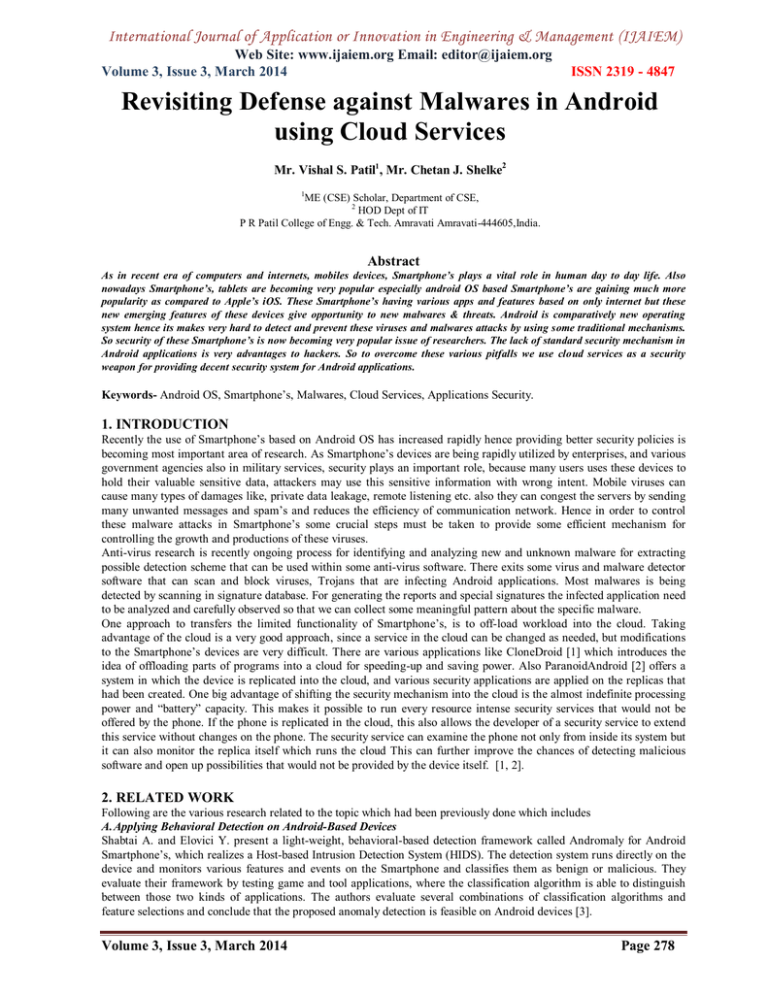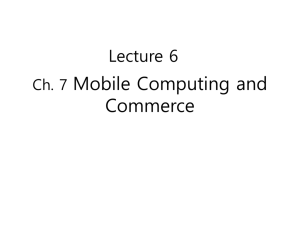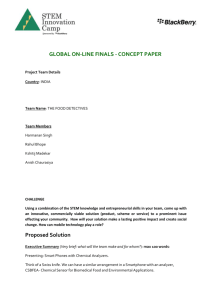International Journal of Application or Innovation in Engineering & Management... Web Site: www.ijaiem.org Email: Volume 3, Issue 3, March 2014
advertisement

International Journal of Application or Innovation in Engineering & Management (IJAIEM)
Web Site: www.ijaiem.org Email: editor@ijaiem.org
Volume 3, Issue 3, March 2014
ISSN 2319 - 4847
Revisiting Defense against Malwares in Android
using Cloud Services
Mr. Vishal S. Patil1 , Mr. Chetan J. Shelke2
1
ME (CSE) Scholar, Department of CSE,
2
HOD Dept of IT
P R Patil College of Engg. & Tech. Amravati Amravati-444605,India.
Abstract
As in recent era of computers and internets, mobiles devices, Smartphone’s plays a vital role in human day to day life. Also
nowadays Smartphone’s, tablets are becoming very popular especially android OS based Smartphone’s are gaining much more
popularity as compared to Apple’s iOS. These Smartphone’s having various apps and features based on only internet but these
new emerging features of these devices give opportunity to new malwares & threats. Android is comparatively new operating
system hence its makes very hard to detect and prevent these viruses and malwares attacks by using some traditional mechanisms.
So security of these Smartphone’s is now becoming very popular issue of researchers. The lack of standard security mechanism in
Android applications is very advantages to hackers. So to overcome these various pitfalls we use cloud services as a security
weapon for providing decent security system for Android applications.
Keywords- Android OS, Smartphone’s, Malwares, Cloud Services, Applications Security.
1. INTRODUCTION
Recently the use of Smartphone’s based on Android OS has increased rapidly hence providing better security policies is
becoming most important area of research. As Smartphone’s devices are being rapidly utilized by enterprises, and various
government agencies also in military services, security plays an important role, because many users uses these devices to
hold their valuable sensitive data, attackers may use this sensitive information with wrong intent. Mobile viruses can
cause many types of damages like, private data leakage, remote listening etc. also they can congest the servers by sending
many unwanted messages and spam’s and reduces the efficiency of communication network. Hence in order to control
these malware attacks in Smartphone’s some crucial steps must be taken to provide some efficient mechanism for
controlling the growth and productions of these viruses.
Anti-virus research is recently ongoing process for identifying and analyzing new and unknown malware for extracting
possible detection scheme that can be used within some anti-virus software. There exits some virus and malware detector
software that can scan and block viruses, Trojans that are infecting Android applications. Most malwares is being
detected by scanning in signature database. For generating the reports and special signatures the infected application need
to be analyzed and carefully observed so that we can collect some meaningful pattern about the specific malware.
One approach to transfers the limited functionality of Smartphone’s, is to off-load workload into the cloud. Taking
advantage of the cloud is a very good approach, since a service in the cloud can be changed as needed, but modifications
to the Smartphone’s devices are very difficult. There are various applications like CloneDroid [1] which introduces the
idea of offloading parts of programs into a cloud for speeding-up and saving power. Also ParanoidAndroid [2] offers a
system in which the device is replicated into the cloud, and various security applications are applied on the replicas that
had been created. One big advantage of shifting the security mechanism into the cloud is the almost indefinite processing
power and “battery” capacity. This makes it possible to run every resource intense security services that would not be
offered by the phone. If the phone is replicated in the cloud, this also allows the developer of a security service to extend
this service without changes on the phone. The security service can examine the phone not only from inside its system but
it can also monitor the replica itself which runs the cloud This can further improve the chances of detecting malicious
software and open up possibilities that would not be provided by the device itself. [1, 2].
2. RELATED WORK
Following are the various research related to the topic which had been previously done which includes
A. Applying Behavioral Detection on Android-Based Devices
Shabtai A. and Elovici Y. present a light-weight, behavioral-based detection framework called Andromaly for Android
Smartphone’s, which realizes a Host-based Intrusion Detection System (HIDS). The detection system runs directly on the
device and monitors various features and events on the Smartphone and classifies them as benign or malicious. They
evaluate their framework by testing game and tool applications, where the classification algorithm is able to distinguish
between those two kinds of applications. The authors evaluate several combinations of classification algorithms and
feature selections and conclude that the proposed anomaly detection is feasible on Android devices [3].
Volume 3, Issue 3, March 2014
Page 278
International Journal of Application or Innovation in Engineering & Management (IJAIEM)
Web Site: www.ijaiem.org Email: editor@ijaiem.org
Volume 3, Issue 3, March 2014
ISSN 2319 - 4847
B. Crowdroid: Behavior-Based Malware Detection System for Android
Burguera et al. present a framework for obtaining and analyzing Smartphone application activities called Crowdroid.
Their framework monitors system calls of applications on the Smartphone’s of many users, and analyzes these samples at
a central server. Scope of the framework is to differentiate between benign applications and their corresponding malware
versions. Since Smartphone users can install applications not only from the official application market, but e.g., from the
Internet, there can exit’s copies of benign applications, with added malware functionality. Burguera et al. show that their
framework is a promising approach to distinguish between a benign application and the corresponding malicious version
[4].
C. Detection of Smartphone Malware
Schmidt A.-D.’s dissertation gives a detailed overview of the evolution and present status of smartphone malware. The
dissertation introduces dynamic and static analysis concepts to detect malware. For dynamic analysis, a user behaviorand application behavior-based concept is described and evaluated on Symbian OS, Windows Mobile and Android. He
also states that function and library calls can be used to successfully detect malware for Android and Symbian OS [5].
D. A cloud-based intrusion detection and response system for mobile phones
Houmansadr et al. propose a cloud-based intrusion detection and response architecture. Its objectives are transparent
operations to the user, light resource usage, and real time and accurate intrusion detection and response. The architecture
emulates a smartphone in the cloud and uses a proxy to duplicate all traffic between the smartphone and the Internet.
Intrusion detection on the emulated smartphone is done using resource intense off-the-shelf intrusion forensics and
detection systems. To keep the device and the emulated device synchronized, the system replicates the user’s input in the
cloud. Once misbehavior is detected, the architecture automatically decides upon the best countermeasure, and sends it to
the device. A prototype of the forensics engine in the cloud uses a set of intrusion detection systems and the logging of
system calls to analyze the installed application [6].
E. Paranoid Android: versatile protection for Smartphone’s
Portokalis et al. present a prototype called Paranoid Android for security checking of Android Smartphone’s on remote
servers hosting exact replicas of the phones. The prototype uses previously recorded system traces to replay the actions of
the real smartphone in the replicas. The remote servers can then perform security scans on the replicas, including antivirus scans and dynamic taint checking. An evaluation of the prototype showed that the transmission overhead can be
kept below 2.5 KiBps, but the battery life is reduced by about 30%. The authors explain how the battery consumption
could be improved significantly and conclude that the architecture is suitable for protection of mobile phones [7].
F. Monitoring Smartphones for Anomaly Detection
Schmidt et al. demonstrate how a smartphone running Symbian OS can be monitored to extract features for anomaly
detection. The features are sent to a remote server to perform analysis using intrusion detection systems on the data. The
paper shows the data extracted from different applications, and how this data can be interpreted [8].
G. Virtualized In-Cloud Security Services for Mobile Devices
Oberheide et al. introduce a model for moving anti virus functionality to an off-device network service which employs
multiple malware detection engines. They argue that this
model has three benefits: better detection through multiple detection engines, reduced on device
resource consumption through offloading of computation and reduced on-device software complexity, since all malware
detection is done in the network. A prototype for this model is developed for Nokia N800 and N95 devices running
Symbian OS. They show that their approach is feasible and effective for the current generation of Smartphone [9].
H. XManDroid: A New Android Evolution to Mitigate Privilege Escalation Attacks
Bugiel et al. propose a security framework called XManDroid to detect and prevent application- level privilege escalation
attacks at runtime. Their prototype for Android OS dynamically analyzes the applications’ permission usage with only
minimal overhead. It is able to detect covert channels which can be established using Android’s system services or
content providers. They evaluate the prototype against known application-level privilege attacks and conclude that their
prototype is capable of detecting several attacks, but also reports some false positives [11].
I. Security as a Service in Cloud for Smartphones
Lakshmi S. proposed a generic architecture for a security service for smartphones and use cases how the service can be
used. The architecture was analyzed in terms of its security aspects and experimental performance and battery
measurements are presented, which show the benefits of such a service in the cloud [10].
3. SYSTEM IMPLIEMENTATION & WORKING
As our main area of discussion is android application security hence we will try to overcome some of the shortcomings of
the various present security policies. In this system when user actually downloads any application available on application
market then all the services, permissions, and signatures of that particular application are extracted using manifest.xml file.
Proposed system mainly consists of three modules which are listed below also following figure shows the system
architecture
Volume 3, Issue 3, March 2014
Page 279
International Journal of Application or Innovation in Engineering & Management (IJAIEM)
Web Site: www.ijaiem.org Email: editor@ijaiem.org
Volume 3, Issue 3, March 2014
ISSN 2319 - 4847
Figure: System Architecture
1. Performing Signature Analysis.
In this module actual decompilation of installed .apk files available on the system is performed. Also depending upon the
signatures, services, permissions and layout screens available in the particular application they are classified as very light,
light, medium, heavy, very heavy applications.
2. Cloud Integration
All user feedback generated for specific application are stored on server that is on cloud using local wamp server. It will
store package name for which that feedback is reported also date of report also imei number (sim 1 only) from which the
report is received from and at last report that is we store value 1 if it good application and 0 for application which
contains virus..
3. User Feedback Detection.
In the last module we create some filter on application with desired name category like Sms, Bluetooth etc. And we can
add some permission set for which we want to add that filter. Hence in this module user can actually generate report and
send it to server. If report is already available on cloud it will give message like report already available. Also one can
uninstall the application for which we user get more and more score.
A. Algorithm Used (Apriori Malware Detection Algorithm)
In this system we used apriori malware detection algorithm for detection of malware present in the application. The
Apriori can be used to detect the association rule of the malware for coordinated attacks. It was designed to detect
significant correlations of set of items for extracting rules of items with high support (a fraction of the subset of items).
This algorithm check yhe confidence index that is confidence about the condition being true or false regarding malware is
present in the application or not, if the confidence index is greater than 50% then there may be chance that application is
malicious and if not it is safe application, that is
If (Ci>0.5)
{
Malicious application
}
Else
{
Safe Application
}
B. How System Works
First of all using eclipse android application development tool we create .apk file of our application (i.e. applizer.apk) and
install it on any Smartphone. Then start the application and also start the local wamp server, then it we list all the
application that are installed on that device with the category that application is belongs to that is light, heavy etc. Then
we will create filter for required set permission with any desired name, in which we have to select some permission for
application then we have to choose filter color which is then displayed on the permission for that application from which
we can say to which filter that application belongs. Then select any application from applizer application list then there
appear some option from which select online operation then user can select any option for registering their feedback for
that particular option and that feedback so generated will be stored on local wamp server
Volume 3, Issue 3, March 2014
Page 280
International Journal of Application or Innovation in Engineering & Management (IJAIEM)
Web Site: www.ijaiem.org Email: editor@ijaiem.org
Volume 3, Issue 3, March 2014
ISSN 2319 - 4847
4. CONCLUSION
Thus this paper introduced a security mechanism for Smartphone’s, which uses user feedback report generated by user, to
check whether the application is malicious or not. We uses apriori algorithm for malware detection. As Smartphone’s are
very much prone to viruses and malwares hence we introduces new approach of using cloud as a security weapon for
providing security. Also literature review section covers all the related work which has been previously carried out related
to this topic. Also we provided user feedback analysis as a solution to the problems of malwares in Android applications.
References:
[1] Byung-Gon Chun and Petros Maniatis. Augmented smartphone applications through clone cloud execution. In
Proceedings of the 12th conference on Hot topics in operating systems, 2009.
[2] Georgios Portokalidis, Philip Homburg, Kostas Anagnostakis, and Herbert Bos. Paranoid android: versatile
protection for smartphones. In Proceedings of the 26th Annual Computer Security Applications Conference, 2010.
[3] Asaf Shabtai and Yuval Elovici. Applying behavioral detection on android-based devices. In MOBILWARE, pages
235–249, 2010.
[4] A D Schmidt. Detection of Smartphone Malware. PhD thesis, Technischen Universit¨at Berlin, 2011.
[5] Amir Houmansadr, Saman A. Zonouz, and Robin Berthier. A cloud-based intrusion detection and response system
for mobile phones. In Proceedings of the 2011 IEEE/IFIP 41st International Conference on Dependable Systems and
NetworksWorkshops, DSNW ’11, pages 31–32,Washington, DC, USA, 2011. IEEE Computer Society.
[6] Iker Burguera, Urko Zurutuza, and Simin N. Tehrani. Crowdroid: behavior-based malware detection system for
Android. In Proceedings of the 1st ACM workshop on Security and privacy in smartphones and mobile devices,
SPSM ’11, pages 15–26, New York, NY, USA, October 2011. ACM.
[7] Georgios Portokalidis, Philip Homburg, Kostas Anagnostakis, and Herbert Bos. Paranoid android: versatile
protection for smartphones. In Proceedings of the 26th Annual Computer Security Applications Conference, 2010.
[8] Aubrey-Derrick Schmidt, Frank Peters, Florian Lamour, and Sahin Albayrak. Monitoring smartphones for anomaly
detection. In Proceedings of the 1st international conference on MOBILe Wireless MiddleWARE, Operating
Systems, and Applications, MOBILWARE ’08, pages 40:1–40:6, ICST, Brussels, Belgium, Belgium, 2007. ICST
[9] Jon Oberheide, Kaushik Veeraraghavan, Evan Cooke, Jason Flinn, and Farnam Jahanian. Virtualized In-Cloud
Security Services for Mobile Devices. In Workshop on Virtualization in Mobile Computing (MobiVirt ’08),
Breckenridge, Colorado, June 2008.
[10] Philipp Stephanow Lakshmi Subramanian, Gerald Q. Maguire Jr. An architecture to provide cloud based security
services for smartphones, 2011.
[11] Sven Bugiel, Lucas Davi, Alexandra Dmitrienko, Thomas Fischer, and Ahmad-Reza Sadeghi. Xmandroid: A new
android evolution to mitigate privilege escalation attacks. Technical report, Technische Universit¨at Darmstadt,
2011.
AUTHORS
Mr. Vishal S. Patil, Received Bachelor’s Degree In Computer Science Engineering from SGB Amravati
University & Pursuing Master Degree In CSE from PR Patil College of Engineering. Amravati-444602
Maharashtra, India
Mr. Chetan J. Shelke, Working as a HOD In Department of Information Technology at PR Patil College of
Engineering. Amravati-444602 Maharashtra, India
Volume 3, Issue 3, March 2014
Page 281



